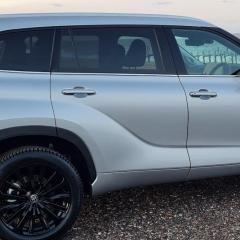Leaderboard
Popular Content
Showing content with the highest reputation on 05/22/2019 in all areas
-
Over the last few years I have tried changing the tyres and wheels on several cars - as the tyres get narrower the steering becomes a little easier to turn. For example, a 195/65 x 15 is an easier steer than the exact the same car on a 205/55 x 16. Are the cars you are comparing fitted with the same tyre sizes?2 points
-
1 point
-
See also https://www.euroncap.com/en/results/toyota/rav4/35881 About time NCAP tests were made compulsory.1 point
-
It is best to remove the nut at the bottom of the shock absorber and then just push the shocker sideways out of the way. You can then get at all the bolts easily. With a 8" socket extension you can tap the socket onto the flange bolts to getit well seated. One of mine I used a not so good ring spanner at first and rounded off the nut head on one of them. I got out of that by hammering on a size smaller socket. I bought a set of 4 new bolts from Toyota for £8-9 as a couple of them were a bit rounded . If a bolt head became rounded you could alway use a blunt chisel or screwdriver and hammer it bearing on the flange which is afair bit bigger than the nuts. Only 4 nuts and good access with the shocker loose. Good luck with it, dont forget the penetrating oil it does make a difference.1 point
-
You can try calibrating the power steering using Techstream, or maybe there will be option to even adjust this. I replaced power steering module on mine, wheel is too light now 😕 so i bought a cable to calibrate it, and hopefully fix.1 point
-
I've not driven a Prius+, but I don't recall noticing any deference between my Gen 3 & 4 Prius, both seemed pretty light but sufficiently weighted. Both also had 15" wheels, rather than the more common 17", the latter being wider (which is why they cause worse Drag Coefficient and fuel consumption), so maybe that makes the steering slightly heavier. Also the rubber compound in the tyres can make a difference - many years ago I replaced all 4 tyres on a car and swapped Pirellis (very grippy, but didn't last long) for Michelin XZX which were claimed to be harder wearing. The (non power assisted) steering was noticeably lighter on the Michelins.1 point
-
Less power steering assistance?1 point
-
By "EV Mode", do you mean EV button pressed or just normal,"gliding" EV mode? I don't remember having noticed wha you descripe and if I did, it didn't bother me. the 2.0 i, obviously, faster but the Danish £5,000 premium is too much. For my style of driving (very cautious and not agressive) I guess the 1.8 will do just fine. I actually found the new 122 BHP quicker and more responsive than my own 2013 136 BHP.1 point
-
For the purposes of updating this posting, the problem was resolved after cleaning the throttle body.1 point
-
My 10% has come back, and you wont believe how. I has often bought fuel system cleaners, probably without any effect at all. This time I got a Fuel Injector Cleaner, and what a difference. Something has been clogged up, and has now been cleaned out. The improvement in fuel economy is so significant, that my own variation in speed or driving style, can't make such difference by it self.1 point
-
Mine does the same, slight clunk in gears 1 to 3 if accelerating briskly. Doesn't do it when lifting clutch slowly. Has done it for the past 20k miles, so not worried that the drivetrain is gonna explode or anything. Have heard other Aygos make the same clunk, so assume it's an Aygo thing, although some louder than others. I usually shift around the 3k rpm mark.1 point
-
Some members have purchased Toyota extended warranties - currently good value as they are offering two years for the price of one. Also includes 2 free MOT's and Toyota Roadside Assistance - https://www.toyota.co.uk/owners/warranty/extended-warranty Servicing has to be done via Toyota's dealer network.1 point
-
You'll tend to find as it gets closer to full, the car will try increasingly harder to use up electric power to try to ensure there's always room for 'free' regenerated energy. Conversely, it tries increasingly harder to top up the battery the lower it gets (from two bars - I've almost never seen just one bar) so there's power available when you need an extra boost from the Motor/Generators. You'll notice more revs for a given accelerator pressure when the battery is low, especially if accelerating up an incline (even quite a gentle one).1 point
-
.........my best shot would be worn, or even just loose engine/gearbox mount(s). Replaced a few of these on my "former life" in the trade ! ( Not necessarily on Aygo, but usually a good starting point with the symptoms given on any car.).1 point
-
I've tested the Touring Sports on both engines. The 1.8 is a quite good car, I'd buy it as it is the most proved hybrid powertrain on the market, has been continuously improved over the years, and is very frugal. But... I wanted to try the new 2.0... I had to feel the new generation of engines that will fit all new Toyota and Lexus models. For the ones that don't know, the M20A-FXS Dynamic Force engine is the second of a family of engines regarded by Toyota as the new and best ever generation of ICE for both conventional and hybrid powertrains. The 2.0 powers the Corolla HB and Touring Sports and the Lexus UX 250. It's older 2.5l brother, the M25A-FXS, powers the Camry, RAV 4, IS 300h, ES 300h, NX 300h and RC 300h. They're high output and high efficiency engines, with on the 2.0, 54kW/l and thermal efficiency of 41% (for HV, 63kW/l and 40% for conventional powertrains) and on the 2.5, 52kW/l and thermal efficiency of 41% (for HV, 61kW/l and 40% for conventional powertrains). It's quite remarkable, technically, at least on paper, that both high efficiency and high output can be labelled on the same engine, as we're used to get either one or the other. On top of the new engine, the 2.0 version get's the new Direct-shift CVT with the launch gear that promises shorter shift speed and higher fuel efficiency. And I'll start from here: it's great! The car answered any stronger move of my right foot with a immediate rev increase (from about 2.000 to 3.000) and delivering the torque and power needed to perform an effortless acceleration, with a reaction that it's at least equivalent of my Corolla Verso's 136hp and 310Nm 2.2 D-4D. Not bad at all for a fuel efficient hybrid! On a slight up hill wet street, starting from full stop with a stronger push of the accelerator, taught me that if I didn't want the VSC/ASR to come into action, I should have been more gentle... The test drive was... too short! The car feels smoother and more quite with this engine, reacting very well for a long station wagon with chassis handling well the increased torque and power. I tend to drive more on the highway than on city so I've decided to pay the engine premium and ordered the 2.0 version. For anyone that calls hybrids dull, test this new Corolla and change your perspective...1 point



